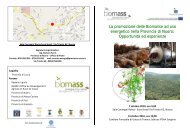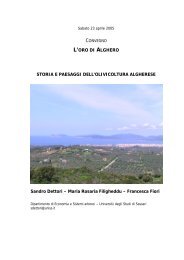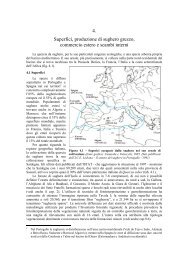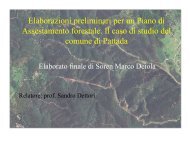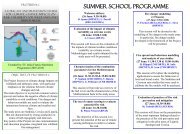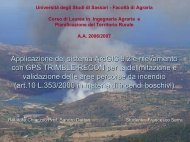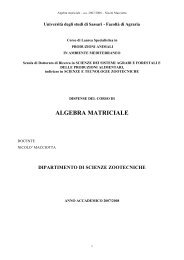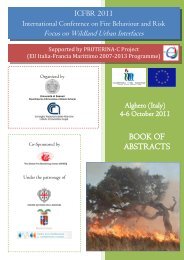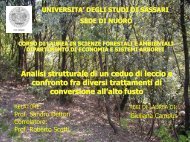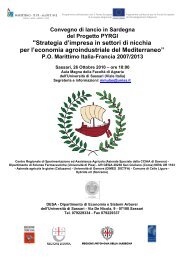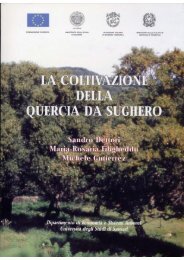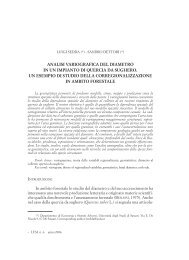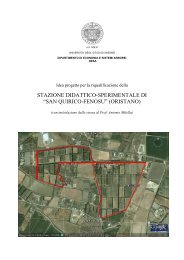Confronto tra 10 cultivar di ciliegio dolce (Prunus avium L.) nella ...
Confronto tra 10 cultivar di ciliegio dolce (Prunus avium L.) nella ...
Confronto tra 10 cultivar di ciliegio dolce (Prunus avium L.) nella ...
You also want an ePaper? Increase the reach of your titles
YUMPU automatically turns print PDFs into web optimized ePapers that Google loves.
<strong>Confronto</strong> <strong>tra</strong> <strong>10</strong> <strong>cultivar</strong> <strong>di</strong> <strong>ciliegio</strong> <strong>dolce</strong> (<strong>Prunus</strong> <strong>avium</strong> L.) <strong>nella</strong> collina me<strong>di</strong>terranea<br />
Sweet cherry performance in a hillside me<strong>di</strong>terranean environment<br />
Dettori S., Falqui A., Filigheddu M.R.<br />
Atti “Convegno del Ciliegio”, Vignola (MO), <strong>10</strong>-11 giugno 1992: 92-95, 1994<br />
Ten sweet cherry varieties (“Bigarreau Burlat” and its compact mutants “Burlat C” and<br />
“Burlat C1”; “Bigarreau Moreau” and its compact mutant “Moreau C”; the Apulian “Ferrovia” and<br />
“Forlì”; the Sar<strong>di</strong>nian “Durone <strong>di</strong> Osini” and “Marracocca”; and “Vittoria”, suitable for mechanical<br />
harvesting) were evaluated in hillside area of Gallura region (Sar<strong>di</strong>nia). Observations were made,<br />
from 1988 to 1992, on a randomised block with four 5-trees replications planted in 1983. The results<br />
of this research evidenced two positive correlations between yield and average maximum<br />
temperature during flowering, and between yield and number of hours with temperatures higher<br />
than 12° C during flowering. The most productive <strong>cultivar</strong>s were the Apulian “Forlì” and<br />
“Ferrovia”, and “Burlat C1”, reducing tree spacing resulted in an increase of total yield by 55, 73<br />
and 87% respectively for “Moreau C”, “Burlat C1” and “Burlat C”. Good performances for fruit<br />
quality were obtained by “Ferrovia” and “Burlat C1”. The rootstock “Colt” showed a poor<br />
resistance to drought, graft incompatibility (especially with “Marracocca”), and sensitivity to<br />
Agrobacterium tumefaciens.<br />
Keywords: sweet cherry, rootstock, Sar<strong>di</strong>nia.<br />
La ricerca ha previsto il confronto <strong>tra</strong> <strong>10</strong> <strong>cultivar</strong>s <strong>di</strong> <strong>ciliegio</strong> <strong>dolce</strong> messe a <strong>di</strong>mora nel 1983<br />
(“Bigarreau Burlat” e i suoi mutanti compatti “Burlat C” e “Burlat C1”; “Bigarreau Moreau” con il<br />
mutante compatto “Moreau C”; le pugliesi “Ferrovia” “Forlì”; le <strong>cultivar</strong> sarde “Durone <strong>di</strong> Osini” e<br />
“Marracocca”; e la “Vittoria” <strong>cultivar</strong> da raccolta meccanica) ed è stata condotta in un’area <strong>di</strong> alta<br />
collina della Gallura (Sardegna nordoccidentale). Le osservazioni sono state condotte dal 1988 al<br />
1992 su blocchi randomizzati con 4 ripetizioni e parcelle <strong>di</strong> 5 piante. I risultati <strong>di</strong> questa ricerca hanno<br />
evidenziato l’esistenza <strong>di</strong> correlazioni positive <strong>tra</strong> produzione e: temperature massime e me<strong>di</strong>e,<br />
quantità <strong>di</strong> ore in caldo (temperatura maggiore <strong>di</strong> 12°C) durante la fioritura. Le <strong>cultivar</strong> più<br />
produttive sono state le pugliesi “Forlì”, “Ferrovia” e la “Burlat C1”; riducendo la <strong>di</strong>stanza <strong>tra</strong> gli<br />
alberi è risultato un aumento della produzione del 55, 73 % ed 87 % rispettivamente per “Moreau<br />
C”, “Burlat C” e “Burlat C1”.Buoni risultati per ciò che riguarda la qualità del frutto sono stati<br />
ottenuti con “Ferrovia” e “Burlat C1”. Il portinnesto “Colt” ha mos<strong>tra</strong>to modesta resistenza alla<br />
siccità, incompatibilità d’innesto (soprattutto per la “Marracocca”) e notevole sensibilità<br />
all’Agrobacterium tumefaciens.<br />
Parole chiave: <strong>ciliegio</strong> <strong>dolce</strong>, portinnesto, Sardegna.<br />
-------------------------------------------------------------------<br />
Stima lisimetrica dei consumi idrici dell’arancio cv “Washington navel”<br />
“Washington navel” orange water requirement estimate from lysimeter<br />
Dettori S., Filigheddu M.R.<br />
Frutticoltura, 56(7-8): 55-57, 1994<br />
“Washington Navel” orange trees water requirements were measured by drainage<br />
lysimeters under drip irrigation from fruit setting to veraison. The lysimeter data were firstly<br />
1
eferred to a planting <strong>di</strong>stance of 4.0 x 2.5 m (4, 5 and 6-year-old trees) and thereafter of 4.0 x 5.0<br />
m (<strong>10</strong> year-old trees). In the first case seasonal water requirements ranged from 190 to 330 mm,<br />
while the water daily consumption / tree ranged from 7 to 28 l; crop coefficients (being ETo from<br />
Class A pan) reached a maximum value 130 days after fruit-setting in accor<strong>di</strong>ng to fruit growth. In<br />
the second case seasonal water requirements were of 223 mm, with a daily consumption from 7 to<br />
36 l. 60% ETc induced a significant decrease of tree growth, yield and fruit quality, and produced<br />
fruit with ticker peel and less juice content.<br />
Keywords: “Washington Navel” orange, evapo<strong>tra</strong>nspiration, lysimeter.<br />
La stima lisimetrica dei consumi idrici dell’arancio “Washington Navel” dal quinto al settimo<br />
anno <strong>di</strong> vita (con <strong>di</strong>stanze <strong>di</strong> piantagione <strong>di</strong> m 4 x 2,5 e in<strong>di</strong>ce <strong>di</strong> copertura del 25-30%) ha messo in<br />
evidenza, dall’allegagione all’invaiatura, dei fabbisogni idrici compresi <strong>tra</strong> mm 190 e 330, con<br />
consumi per pianta compresi <strong>tra</strong> 7 (all’invaiatura del quarto anno) e 28 l/giorno (a 45 giorni<br />
dall’allegagione al sesto anno); i coefficienti colturali, compresi al sesto anno <strong>tra</strong> 0,48 (a 30 giorni<br />
dall’allegagione) e 0,77 (a 120 giorni dall’allegagione), sono risultati correlati coll’accrescimento del<br />
frutto piuttosto che con l’ETo da vasca <strong>di</strong> classe A. Al decimo anno, con <strong>di</strong>stanze <strong>di</strong> piantagione <strong>di</strong><br />
m 4 x 5 e in<strong>di</strong>ce <strong>di</strong> copertura del 42%, il consumo per pianta è oscillato da 7 (all’invaiatura) a 36<br />
l/giorno (a 60 giorni dall’allegagione), mentre i kc <strong>tra</strong> 0,48 e 0,35, nell’or<strong>di</strong>ne, a 15 e 120 giorni<br />
dall’allegagione. In questa fase la restituzione del 60% dell’ETc ha comportato una riduzione nello<br />
sviluppo e <strong>nella</strong> produttività delle piante e ha fornito frutti con buccia più spessa e minore resa in<br />
succo. La maggiore efficienza idrologica si è ottenuta con la restituzione dell’80% ETc, volume<br />
idrico che non ha penalizzato i livelli produttivi anche se ha ridotto leggermente il peso dei frutti<br />
rispetto al <strong>10</strong>0% ETc.<br />
Parole chiave: arancio “Washington Navel”, evapo<strong>tra</strong>spirazione, lisimetro.<br />
-------------------------------------------------------------------<br />
Verification of the surface renewal method for estimating evapo<strong>tra</strong>nspiration<br />
Verifica del metodo “surface renewal” per la stima dell’evapo<strong>tra</strong>spirazione<br />
Spano D., Snyder R.L., Paw U K.T., De Fonso E.<br />
Atti 21° Conferenza “Agricultural and Forest Meteorology”, San Diego (CA), March 7-11:<br />
297-298, 1994<br />
The surface renewal analysis (SR) for determining sensible heat flux density (H) can be<br />
used with net ra<strong>di</strong>ation and soil heat flux density to estimate evapo<strong>tra</strong>nspiration (ET). The SR<br />
analysis uses high frequency recor<strong>di</strong>ngs above canopies to identify temperature ramps and to<br />
determine H. Temperature measurements (8Hz) were taken at three <strong>di</strong>fferent heights over a 0.05m<br />
tall turfgrass (Alta fescue). Sonic anemometer measurements were taken at a height of 0.7 m to<br />
obtain an independent measure of H. All H values were calculated as half hour means. The results<br />
showed that high frequency temperature measurements should be made well above a low growing<br />
canopy and α=1 in H calculation gave good estimate of Eddy Covariance H.<br />
Keywords: evapo<strong>tra</strong>spiration, surface renewal analysis, air temperature.<br />
L’analisi surface renewal (SR) per la stima della densità del flusso <strong>di</strong> calore sensibile (H)<br />
può essere usata con le densità <strong>di</strong> flusso <strong>di</strong> ra<strong>di</strong>azione netta e <strong>di</strong> calore nel suolo per il calcolo<br />
dell’evapo<strong>tra</strong>spirazione. L’analisi SR si basa su misure <strong>di</strong> temperatura dell’aria rilevata ad elevata<br />
2
frequenza sopra la struttura vegetale. A tal fine sono state effettuate misure <strong>di</strong> temperatura (8Hz) a<br />
tre <strong>di</strong>verse quote al <strong>di</strong> sopra <strong>di</strong> un prato <strong>di</strong> festuca <strong>di</strong> 0,05 m d’altezza. Una misura in<strong>di</strong>pendente del<br />
flusso <strong>di</strong> H è stata ottenuta da un anemometro sonico posizionato a 0,7 m al <strong>di</strong> sopra della<br />
vegetazione. Tutti i valori <strong>di</strong> H sono stati me<strong>di</strong>ati sui trenta minuti. I risultati ottenuti hanno<br />
evidenziato che le misure <strong>di</strong> temperatura per l’analisi SR dovrebbero essere effettuate bel al <strong>di</strong><br />
sopra dal top della vegetazione e un coefficiente α=1 consente <strong>di</strong> ottenere una buona stima <strong>di</strong> H se<br />
confrontata con i valori ottenuti dal metodo Eddy Covariance.<br />
Parole chiave: evapo<strong>tra</strong>spirazione, analisi surface renewal, temperatura dell’aria.<br />
-------------------------------------------------------------------<br />
L’innesto in vivaio della quercia da sughero su Quercus suber e Quercus ilex<br />
Nursery grafting of cork oak on Quercus suber and Quercus ilex<br />
Azzena M., Deidda P., Falqui A., Pod<strong>di</strong>ghe D.<br />
Cellulosa e Carta, 45(5/6): 18-21, 1994<br />
A study was carried out to evaluate nursery grafting of Q. suber. Grafts were made on<br />
three year old seedlings of the same species and on Q. ilex. Peg grafting was carried out at four<br />
weekly intervals, starting from 1 st of April, with the aim of identifying the optimum grafting time.<br />
The highest attachment percentage was obtained from grafts made 1/4/93, with 93.3% on Q. suber<br />
and 86.7% on Q. ilex. Con<strong>tra</strong>ry to a previous work the scions were collected and grafted on the<br />
same day, which has resulted in an increase of successful grafts.<br />
Keywords: Quercus suber, Quercus ilex, propagation, grafting.<br />
La presente nota riferisce <strong>di</strong> una prova d’innesto della quercia da sughero (Quercus suber<br />
L.) su semenzali della medesima specie e <strong>di</strong> leccio (Quercus ilex L.) <strong>di</strong> tre anni d’età <strong>di</strong>sposti in<br />
piantonaio. E’ stato effettuato l’innesto a spacco pieno in testa in 4 interventi a cadenza settimanale,<br />
al fine <strong>di</strong> verificare il periodo ottimale. Le migliori percentuali <strong>di</strong> attecchimento sono state ottenute<br />
negli innesti effettuati il 1° aprile 1993, con valori pari al 93,3% in quelli su sughera, ed all’86,7% in<br />
quelli su leccio. A <strong>di</strong>fferenza <strong>di</strong> un precedente lavoro le marze sono state prelevate il giorno stesso<br />
dell’innesto anzichè durante l’inverno, il che ha consentito un considerevole incremento delle<br />
percentuali <strong>di</strong> successo.<br />
Parole chiave: Quercus suber, Quercus ilex, propagazione, innesto.<br />
-------------------------------------------------------------------<br />
Evaluation of almond germplasm in Sar<strong>di</strong>nia: further observations<br />
Valutazione del germoplasma <strong>di</strong> mandorlo in Sardegna<br />
Nieddu G., Chessa I., Pala M., Lovicu G.<br />
Acta Horticulturae, 373: 135-139, 1994<br />
3
Thirty-six varieties selected among the Sar<strong>di</strong>nian almond germplasm have been gathered in<br />
a collection field located in southern Sar<strong>di</strong>nia in order to safeguar<strong>di</strong>ng and exploiting the<br />
autochthonous almond population. The horticultural characteristics of the selected varieties were<br />
previously observed on mother plants and lately in the collection field, at the same growing<br />
con<strong>di</strong>tions and comparatively to <strong>cultivar</strong>s widely grown. The results of the observations conducted in<br />
the last three years have shown the range and classes of frequencies of main morphological <strong>tra</strong>its of<br />
the trees growth habitus and fruiting behaviour, of buds and flowers, and fruit. The attention have<br />
been also drawn on flowering process and chemical as nutritional composition of fruit.<br />
Keywords: almond germoplasm, collection field.<br />
Trentasei varietà <strong>di</strong> mandorlo selezionato <strong>tra</strong> germoplasma sardo sono state raccolte in un<br />
campo collezione situato <strong>nella</strong> Sardegna meri<strong>di</strong>onale per salvaguardare e valorizzare le popolazioni<br />
autoctone <strong>di</strong> mandorlo. Le caratteristiche orticolturali delle varietà selezionate sono state osservate<br />
dapprima sulle piante madri e successivamente nel campo collezione, nelle stesse con<strong>di</strong>zioni <strong>di</strong><br />
crescita e a confronto con le <strong>cultivar</strong> cresciute spontaneamente. I risultati delle osservazioni portate<br />
avanti negli ultimi tre anni, hanno mos<strong>tra</strong>to il range e le classi <strong>di</strong> frequenza dei principali caratteri<br />
morfologici dell’habitus vegetativo e riproduttivo degli alberi, delle gemme, dei fiori e del frutto.<br />
L’attenzione è stata anche portata sul processo <strong>di</strong> fioritura e sulla composizione chimico nutrizionale<br />
del frutto.<br />
Parole chiave: mandorlo, germoplasma, campo collezione.<br />
-------------------------------------------------------------------<br />
Biologia fiorale e <strong>di</strong> fruttificazione dell’ Annona cherimola (cv “Fino de jete”)<br />
Reproductive behaviour of Annona cherimola (cv “Fino de jete”)<br />
Nieddu G., Chessa I., Pala M., Lovicu G.<br />
Italus Hortus, 1(5-6): 40-46, 1994<br />
The aim of the present research is to describe the vegetative and reproductive behaviour of<br />
Annona cherimola, growing in Sar<strong>di</strong>nia where the species has been recently introduced. The<br />
observations were conducted during the 1991-92 on three-year old trees of the cv Fino de Jete<br />
growing at the C.R.A.S. (Centro Regionale Agrario Sperimentale) experimental fields in a<br />
subtropical area of southern Sar<strong>di</strong>nia. Ten shoots per tree, with a total of five trees, were selected<br />
for biological observations. These were related to bud evolution, flower and fruit development and<br />
were compared to air temperature and relative humi<strong>di</strong>ty recorded before and during flowering<br />
phase. Pollen samples were also collected and then observed for morphological characters and<br />
viability. Pollen viability was also recorded after 1-year storage at low temperature (4°C and -18°C<br />
respectively). Differences in phenological phases were observed in 1991 and 1992. Flower onset<br />
was recorded from the end of may and the beginning of june in 1991 and in the first decade of may<br />
in 1992, while in both years flowering started one month later. During full bloom a great amount of<br />
flower-drop was observed, as well as protogynoecia. Stigma receptivity time changed from ten<br />
hours in the first year to three days in the second one. Environmental con<strong>di</strong>tions, mainly air<br />
temperature and relative humi<strong>di</strong>ty, affected flowering process and fruit set. The earliness in the<br />
phenological stages, mainly blooming time, was related to high temperature before anthesis; at the<br />
same time low temperature and high relative humi<strong>di</strong>ty during flowering increased the length of<br />
stigma receptivity period. Pollen viability, low when checked soon after pollen sampling, was further<br />
reduced after one year storage both at 4°C and -18°C. The <strong>di</strong>fficulty to germinate has been related<br />
to the high percentage of pollen grains in the te<strong>tra</strong>d stage. Self pollination was unsuccessful and<br />
4
even the artificial pollination <strong>di</strong>d not improve fruit set. The poor fruit set percentage besides<br />
protogynoecia, adverse meteorological con<strong>di</strong>tions and low pollen viability, was also affected by<br />
flower morphology which resulted in a very scarce pollination by insects.Fruit growth pattern was<br />
similar to a double sigmoid curve. The first growing period was followed by a steady stage of a<br />
month and by a short second phase of intensive growth. Finally, in both years, fruit at the end of<br />
growth stage resulted undersized.<br />
Keywords: Annona cherimola, flowering, pollen, fruit.<br />
L’Annona cherimola (Mill.) presenta una particolare biologia riproduttiva, essendo<br />
caratterizzata da fiori <strong>di</strong>cogami e proterogini, tale quin<strong>di</strong> da limitarne fortemente la produttività. La<br />
scarsa allegagione, unitamente ai problemi <strong>di</strong> adattabilità ambientale, con<strong>di</strong>ziona l’introduzione della<br />
specie in nuovi areali <strong>di</strong> coltivazione. La presente ricerca è stata condotta per un biennio in un<br />
annoneto situato nel Sud della Sardegna. Le osservazioni fenologiche, effettuate per tutta la stagione<br />
vegetativa sulle gemme presenti in <strong>di</strong>eci germogli scelti su cinque piante, hanno consentito la<br />
definizione della durata <strong>di</strong> ciascuna fenofase. Durante la fioritura è stato osservato che la fase<br />
femminile ha una breve durata, variabile, nei due anni, in <strong>di</strong>pendenza del <strong>di</strong>fferente andamento<br />
meteorologico.Osservazioni sono state condotte, altresì, sulla germinabilità e morfologia del polline.<br />
Infine, è stata rilevata la curva <strong>di</strong> accrescimento dei frutti, risultata assimilabile ad una doppia<br />
sigmoide.<br />
Parole chiave: Annona cherimola, fioritura, polline, fruttificazione.<br />
-------------------------------------------------------------------<br />
Polyamine levels during the onset of “CAM” in Opuntia ficus-in<strong>di</strong>ca (Miller)<br />
Livelli <strong>di</strong> poliammine all’inizio del ciclo CAM in Opuntia ficus-in<strong>di</strong>ca (Miller)<br />
Deidda P., Tekle Z., Nieddu G., Pintus G., Pinna G.G., Sisini A.<br />
Amino Acids, (7): 203-209, 1994<br />
Polyamines have been related to the “Crassulacean Acid Metabolism” (CAM) in higher<br />
plants. Such relationship was however observed in plants where CAM activity is inducible by<br />
external factors. Results presented here in<strong>di</strong>cate that, in Opuntia ficus-in<strong>di</strong>ca cladodes where<br />
onset of CAM is dependent on internal con<strong>di</strong>tions, i.e. leaf age, the putrescine content increases in<br />
parallel to the cytoplasm aci<strong>di</strong>ty. The putrescine and aci<strong>di</strong>ty increase can be better evaluated during<br />
the onset of CAM (young cladodes), while such correlation was not observed in mature cladodes<br />
where CAM is already in it’s full function. Spermi<strong>di</strong>ne and spermine showed no correlation with<br />
CAM activity neither during the onset of CAM nor during it’s full function. However, spermi<strong>di</strong>ne<br />
levels was negatively correlated to CAM activity when cladodes attained more then 30 days of age.<br />
The results suggested that putrescine in free form could possibly counteract the increase of cellular<br />
aci<strong>di</strong>ty during onset of CAM in Opuntia ficus-in<strong>di</strong>ca. The possible roles of spermi<strong>di</strong>ne are<br />
<strong>di</strong>scussed.<br />
Keywords: Opuntia ficus-in<strong>di</strong>ca, polyamines, CAM.<br />
Le poliammine sono state messe in relazione con il metabolismo CAM nelle piante superiori.<br />
Tale relazione è stata osservata nelle piante dove l’attività CAM è in<strong>di</strong>cibile da fattori esterni. I<br />
risultati qui presentati in<strong>di</strong>cano che in Opuntia ficus-in<strong>di</strong>ca i clado<strong>di</strong> , nei quali l’inizio dell’attività<br />
CAM <strong>di</strong>pende da fattori interni per esempio dall’età della foglia, la concen<strong>tra</strong>zione <strong>di</strong> putrescina<br />
5
aumenta parallelamente all’aci<strong>di</strong>tà del citoplasma. L’incremento parallelo della concen<strong>tra</strong>zione <strong>di</strong><br />
putrescina e dell’aci<strong>di</strong>tà (concen<strong>tra</strong>zione <strong>di</strong> acido malico), può essere ben valutata nei giovani clado<strong>di</strong><br />
all’inizio del ciclo CAM, mentre tale correlazione non è stata osservata nei clado<strong>di</strong> maturi dove il<br />
metabolismo CAM è già pienamente funzionante. La spermi<strong>di</strong>na e la spermina non mos<strong>tra</strong>no alcuna<br />
correlazione con l’attività CAM nè durante l’inizio del metabolismo CAM nè durante il suo pieno<br />
funzionamento. I livelli <strong>di</strong> spermi<strong>di</strong>na sono correlati negativamente con l’attività CAM quando i<br />
clado<strong>di</strong> superano i trenta giorni <strong>di</strong> età. I risultati suggeriscono che la putrescina in forma libera<br />
potrebbe con<strong>tra</strong>stare l’incremento <strong>di</strong> aci<strong>di</strong>tà cellulare durante l’inizio del ciclo CAM in Opuntia<br />
ficus-in<strong>di</strong>ca.<br />
Parole chiave: Opuntia ficus in<strong>di</strong>ca, poliammine, CAM.<br />
-------------------------------------------------------------------<br />
Olive oil quality in relation to enviromental con<strong>di</strong>tions<br />
Qualità dell’olio d’oliva in relazione alle con<strong>di</strong>zioni ambientali<br />
Deidda P., Nieddu G., Spano D., Ban<strong>di</strong>no G., Orru’ V., Solinas M., Serraiocco A.<br />
Acta Horticulturae, 356: 354-357, 1994<br />
A research about the relationship between olive oil quality (cv. “Bosana”) and<br />
environmental con<strong>di</strong>tions was carried out in nine Sar<strong>di</strong>nian’s areas. All the oil samples resulted of<br />
high quality and a better oil quality was observed in hilly areas and in colder environments of<br />
northern Sar<strong>di</strong>nia. Early harvesting also improved the oil quality.<br />
Keywords:Olea europaea, oil quality, enviromental con<strong>di</strong>tions.<br />
Una ricerca sui rapporti <strong>tra</strong> la qualità dell’olio d’oliva (cv “Bosana”) e le con<strong>di</strong>zioni<br />
ambientali è stata svolta in nove aree della Sardegna. Tutti gli oli hanno <strong>di</strong>mos<strong>tra</strong>to <strong>di</strong> avere un<br />
ottima qualità e un miglioramento delle caratteristiche si è osservato nelle zone a maggiore altitu<strong>di</strong>ne<br />
e nel nord dell’isola. Anche la raccolta precoce migliora la qualità dell’olio.<br />
Parole chiave: Olea europea, qualità, olio.<br />
-------------------------------------------------------------------<br />
Mineral content in “Texas” almonds during fruit growth and ripening<br />
Composizione minerale del frutto <strong>di</strong> mandorlo della <strong>cultivar</strong> “Texas” durante l’accrescimento<br />
e la maturazione<br />
Schirra M., Mulas M., Nieddu G., Vir<strong>di</strong>s F.<br />
Acta Horticulturae, 373: 207-214, 1994<br />
This paper describes the changes of macroelements (P, Na, K, Ca and Mg) and<br />
microelements (Cu, Zn, Fe and Mn) in <strong>di</strong>fferent parts of almond fruit (cv “Texas”) during the entire<br />
growing period. During 1988, six samplings were made at monthly intervals from fruit set (20 April)<br />
to crop maturity (20 September). Kernel and hull tissues were separated and analysed after each of<br />
the six samplings. Shell tissue separation and analysis were performed only from the 3rd sampling<br />
6
on. Changes in mineral content during the growing period revealed <strong>di</strong>fferent trends, depen<strong>di</strong>ng on<br />
the tissue analysed. In particular, K, Mg and Fe content showed decreases in the shell, rose in the<br />
kernel and fluctuated in the hull. Irregular trends in amounts of Ca were noted in the shell but<br />
increased considerably in kernel and hull. Relationships between elements in <strong>di</strong>fferent parts of fruit<br />
are <strong>di</strong>scussed.<br />
Keywords:Amygdalus communis, kernel, shell, hull.<br />
Questo lavoro descrive le mo<strong>di</strong>ficazioni <strong>nella</strong> composizione in macro e microelementi nelle<br />
<strong>di</strong>fferenti parti del frutto <strong>di</strong> mandorlo (cv “Texas”) durante l’intero periodo <strong>di</strong> sviluppo. La ricerca è<br />
stata effettuata durante il 1988, e ha previsto campionamenti ad intervalli mensili dall’allegagione alla<br />
piena maturità . I tessuti della mandorla e del mallo sono stati separati ed analizzati dopo ciascun<br />
campionamento. La separazione e l’analisi dei tessuti del guscio è stata effettuata solo dopo il terzo<br />
campionamento. La variazione della composizione minerale durante il periodo <strong>di</strong> sviluppo ha<br />
mos<strong>tra</strong>to <strong>di</strong>verse tendenze a seconda del tessuto analizzato. In particolare il contenuto <strong>di</strong> K, Mg e Fe<br />
mos<strong>tra</strong> un decremento nel guscio, un aumento <strong>nella</strong> mandorla e fluttuazioni nel mallo. Nel guscio la<br />
quantità <strong>di</strong> Ca ha avuto un andamento irregolare, mentre <strong>nella</strong> mandorla e nel mallo si è osservato un<br />
considerevole incremento.<br />
Parole chiave: Amygdalus communis, mandorla, guscio, mallo.<br />
-------------------------------------------------------------------<br />
Quantità e morfologia delle cere epicuticolari durante lo sviluppo <strong>di</strong> gemme vegetative <strong>di</strong><br />
Opuntia ficus-in<strong>di</strong>ca (Mill.)<br />
Quantity and morphology of epicuticolar waxes during vegetative growing of Opuntia ficusin<strong>di</strong>ca<br />
(Mill.) buds<br />
Chessa I., Nieddu G., Tekle Z.<br />
Atti Convegno “II Giornate Scientifiche S.O.I.”, San Benedetto del Tronto, 22-24 giugno:<br />
221-222, 1994<br />
On 200 self-rooted plants of Opuntia ficus-in<strong>di</strong>ca all buds emerging on one-year-old<br />
cladodes in June were counted and grouped into five classes in July 1993 in relation to their<br />
developmental stage. The amount and the morphology of epicuticular waxes were also observed.<br />
The same observations were made at the end of June and two months later on young and mature<br />
cladodes at similar developmental stage, but emerged in <strong>di</strong>fferent times. The results evidenced the<br />
highest wax amount per surface unit in cladodes of the same age but of smaller size, while in<br />
cladodes of the same size but of <strong>di</strong>fferent age the highest amount was recorded in those of<br />
interme<strong>di</strong>ate age. Later growing stage and age negatively influenced the cladodes capability of wax<br />
synthesis. The fine wax structure appeared clearly defined and a cellular-like pattern with a system<br />
of branching rodlets was observed.<br />
Keywords: Opuntia ficus-in<strong>di</strong>ca, waxes, cladodes development.<br />
Nel luglio del 1993, su 200 piante <strong>di</strong> Opuntia ficus-in<strong>di</strong>ca sono state rilevate le date <strong>di</strong><br />
comparsa delle gemme vegetative, su clado<strong>di</strong> <strong>di</strong> un anno, e in base al livello <strong>di</strong> accrescimento sono<br />
state costituite cinque classi <strong>di</strong> grandezza per le osservazioni sulla quantità e sulla struttura delle cere<br />
epicuticolari. Analoghe osservazioni sono state condotte, alla fine <strong>di</strong> giugno e dopo due mesi, su<br />
clado<strong>di</strong> <strong>di</strong> sviluppo omogeneo ma emersi in date <strong>di</strong>fferenti. I risultati evidenziano che la maggior<br />
7
quantità <strong>di</strong> cere per unità <strong>di</strong> superficie si rileva nelle giovani gemme vegetative della medesima età,<br />
mentre a parità <strong>di</strong> sviluppo <strong>di</strong>mensionale, sono i clado<strong>di</strong> <strong>di</strong> età interme<strong>di</strong>a a mos<strong>tra</strong>re i maggiori<br />
accumuli. A sta<strong>di</strong> <strong>di</strong> sviluppo ed età dei clado<strong>di</strong> più avanzati si osserva una ridotta capacità <strong>di</strong> sintesi.<br />
Una regolare struttura delle cere, organizzata in poligoni irregolari e con formazioni a bastoncino, è<br />
stata infine osservata.<br />
Parole chiave: Opuntia ficus-in<strong>di</strong>ca, cere, sviluppo dei clado<strong>di</strong>.<br />
-------------------------------------------------------------------<br />
Ulteriori indagini sulla induzione fiorale nell’arancio “Washington navel”<br />
Further observations on flower bud initiation in the “Washington navel” orange<br />
Nieddu G., Chessa I., Deidda P.<br />
Atti Convegno “II Giornate Scientifiche S.O.I.”, San Benedetto del Tronto, 22-24 giugno: 25-<br />
26, 1994<br />
The role of the spring and autumn vegetative flux on the flower induction was evaluated in<br />
the “Washington Navel” sweet orange by a trial carried out with a progressive sha<strong>di</strong>ng of the shoot<br />
from June to December 1991. During 1992 flowering season the number of leaves and flowers per<br />
bud was recorded in shaded shoots. Flowers were observed in both spring or autumn shoots<br />
evidencing the possibility that induction process can start also in June, but the highest flower<br />
production was found in shoots shaded in December.<br />
Keywords: Citrus, flower bud induction.<br />
Nel presente lavoro è stato verificato il ruolo esercitato dai flussi vegetativi primaverili ed<br />
autunnali sul processo <strong>di</strong> induzione fiorale valutando l’effetto dell’ombreggiamento dei germogli ad<br />
intervalli successivi. In un agrumeto <strong>di</strong> arancio <strong>dolce</strong> “Washington Navel”, per i due flussi<br />
primaverile ed autunnale, sono stati effettuati ad intervalli <strong>di</strong> 15 giorni 5 e 6 perio<strong>di</strong> <strong>di</strong> accrescimento,<br />
rispettivamente da giugno a settembre e da ottobre a <strong>di</strong>cembre, utilizzando una rete nera che<br />
<strong>di</strong>minuisce la ra<strong>di</strong>azione del 30%. Nella successiva fioritura è stata seguita l’evoluzione delle gemme<br />
a fiore, a legno o miste, ed il numero <strong>di</strong> fiori formati utilizzando un controllo non oscurato. Dai<br />
risultati emerge l’apporto <strong>di</strong> en<strong>tra</strong>mbi i flussi vegetativi alla formazione <strong>di</strong> gemme a fiore; il periodo<br />
<strong>di</strong> induzione potrebbe avere inizio già dal mese <strong>di</strong> giugno, ma la maggior produzione si osserva da<br />
fine <strong>di</strong>cembre in coincidenza con i minori perio<strong>di</strong> <strong>di</strong> oscuramento.<br />
Parole chiave: agrumi, <strong>di</strong>fferenziazione antogena.<br />
-------------------------------------------------------------------<br />
Responses of “Marsh seedless” grape fruit to prestorage CaCl2 treatments with or<br />
without fungicides<br />
Risposta del pompelmo “Marsh seedless” a <strong>tra</strong>ttamenti preconservazione con CaCl2 con o<br />
senza fungici<strong>di</strong><br />
Mulas M., Schirra M., Chessa I.<br />
8
Atti Simposio “Postharvest Physiology, Pathology and Technologies for Horticultural<br />
Commo<strong>di</strong>ties: Recent Advances”, Aga<strong>di</strong>r (Marocco), 16-21 gennaio 1994: 51-56, 1994<br />
Results obtained on “Marsh Seedless” grapefruit stored for 3 months at 8°C with 90 to 95%<br />
relative humi<strong>di</strong>ty (RH) and then exposed for one week at 20°C and 75% RH to simulate shelf-life<br />
revealed no significant <strong>di</strong>fferences in the incidence of chilling injury following pretreatment with<br />
CaCl2 or Imazalil (IMZ) compared to untreated fruits. Combined treatment, however, <strong>di</strong>d lead to a<br />
significant increase during shelf-life. The incidence of rotting was negatively influenced by CaCl2,<br />
which favoured its development, especially during the last week of storage and shelf-life. On the<br />
other hand, IMZ greatly inhibited the development of pathogens, and its effectiveness <strong>di</strong>d not appear<br />
to be influenced by CaCl2 when used in combination with it. The overall physiological and chemical<br />
parameters of the fruit revealed a more rapid ageing of fruit treated with CaCl2 compared to<br />
untreated fruit. The results of this experiment on “Marsh seedless” grapefruit revealed no beneficial<br />
effect of postharvest treatments with CaCl2 in maintaining fruit characteristics, which is con<strong>tra</strong>ry to<br />
what has been observed on other species.<br />
Keywords: grapefruit, cold storage, chilling injury, decay, metabolites.<br />
I risultati ottenuti sul pompelmo “Marsh seedless”, conservato per tre mesi a 8 °C con<br />
un’umi<strong>di</strong>tà relativa (UR) del 90-95% e quin<strong>di</strong> esposti per una settimana a 20 °C e 75% <strong>di</strong> UR per<br />
simulare il periodo <strong>di</strong> post-conservazione, non hanno rilevato <strong>di</strong>fferenze significative nell’incidenza<br />
dei danni da freddo susseguenti a un pre<strong>tra</strong>ttamento con CaCl2 o Imazil (IMZ) a confronto col<br />
controllo. I <strong>tra</strong>ttamenti combinati, comunque, <strong>di</strong>edero luogo a un significativo incremento durante la<br />
fase <strong>di</strong> post-conservazione. L’incidenza dei marciumi era influenzata negativamente dal CaCl2, che<br />
ne ha favorito lo sviluppo, specialmente durante l’ultima settimana <strong>di</strong> conservazione e il postconservazione.<br />
D’al<strong>tra</strong> parte, l’IMZ ha inibito in misura importante lo sviluppo dei patogeni, e la sua<br />
efficacia non sembrava essere influenzata dal CaCl2 usato in combinazione con esso. I complessivi<br />
parametri fisiologici e chimici del frutto sottolineavano un più rapido invecchiamento del frutto<br />
<strong>tra</strong>ttato con CaCl2 in confronto al controllo. I risultati <strong>di</strong> questo esperimento sul pompelmo “Marsh<br />
seedless” hanno rivelato l’assenza <strong>di</strong> effetti benefici dei <strong>tra</strong>ttamenti post-raccolta con CaCl2 nel<br />
mantenere le caratteristiche del frutto, fatto che con<strong>tra</strong>sta con quanto osservato in altre specie.<br />
Parole chiave: pompelmo, frigoconservazione, danni da freddo, deca<strong>di</strong>mento, metaboliti.<br />
-------------------------------------------------------------------<br />
Conservabilità dei frutti <strong>di</strong> clementine “Monreal” in relazione ai <strong>tra</strong>ttamenti per<br />
immersione a caldo con cloruro <strong>di</strong> calcio e tiabendazolo<br />
Postharvest storage of “Monreal” clementines as affected by hot-<strong>di</strong>p thiabendazole and<br />
calcium chloride treatments<br />
Schirra M., Mulas M., Baghino L., Mura M.<br />
Italus Hortus, 1 (4): 3-4, 1994<br />
The effect on keeping quality of Monreal clementines of postharvest water <strong>di</strong>p treatment<br />
with or without thiabendazole (TBZ), calcium chloride (CaCl2) and TBZ + CaCl2 at 25 or 50°C was<br />
investigated. Freshly harvested fruits were placed in plastic boxes (<strong>10</strong>0 fruits per box) and grouped<br />
into 8 treatments lots of 6 boxes each, correspon<strong>di</strong>ng to the following <strong>di</strong>fferent 3-min <strong>di</strong>p treatments:<br />
A) water at 25°C; B) water at 50°C; C) 850 ppm TBZ, at 25°C; D) 850 ppm TBZ, at 50°C; E) 2%<br />
CaCl2, at 25°C; F) 2% CaCl2, at 50°C; G) 850 ppm TBZ + 2% CaCl2, at 25°C; H) 850 ppm TBZ +<br />
2% CaCl2, at 50°C. Following treatment the fruits were allowed to dry at ambient temperature and<br />
9
then stored for 8 weeks at 2°C and 90-95% relative humi<strong>di</strong>ty (RH) with a complete change of air in<br />
the cold room every hour. At the end of storage, the fruits were kept for 1 week at 20°C and 75%<br />
RH, to simulate marketing con<strong>di</strong>tions (shelf-life). After 4 and 8 weeks of storage and after shelflife,<br />
fruits were inspected for symptoms of chilling injury (pitting), and decay by mould. Three<br />
replicates of ten healthy fruits were randomly selected imme<strong>di</strong>ately after harvest, after 4 and 8<br />
weeks of cold storage, and after simulated shelf life for chemical analyses. The fruits <strong>di</strong>pped in<br />
water at 50°C showed less chilling injury (CI) and rots than those treated at 25°C. Heat enhanced<br />
fungicide effectiveness by delaying the onset of CI and inhibiting pathogen development under<br />
storage. TBZ at 50°C, either alone or with CaCl2, had positive effects at both temperature regimes<br />
under storage. The combined TBZ and CaCl2 treatment caused no positive effects on fruit quality<br />
because of phytotoxic effects on the rind. At the end of the experiment, fruit weight loss was<br />
slightly reduced as a consequence of water hot-<strong>di</strong>p. TBZ hot-<strong>di</strong>p treatment showed the same effect,<br />
but CaCl2 determined higher weight loss with the bath warmed to 50°C. All treatments reduced<br />
weight loss with the 25°C <strong>di</strong>p. Electrolyte leakage from excised flavedo tissue by 50°C watertreated<br />
fruits was higher than 25°C control. All treatments at 25°C, with the exception of TBZ +<br />
CaCl2, induced higher respiration rates of fruits with respect to those <strong>di</strong>pped at 50°C. TBZ and<br />
CaCl2 also reduced fruit respiration rate. Water-and TBZ-treated fruits at 25°C showed a higher<br />
concen<strong>tra</strong>tion of endogenous ethylene than those treated at 50°C. On the con<strong>tra</strong>ry, CaCl2<br />
determined, in hot <strong>di</strong>pped fruits, an almost total inhibition of ethylene production during storage and<br />
higher levels of same at the end of shelf-life. Juice content of ethanol and acetaldehyde was higher<br />
in fruit <strong>di</strong>pped at 25°C, with the exception of the water-<strong>di</strong>pped control. The trial variable proved to<br />
have slighter effects on internal quality parameters such juice yield, ti<strong>tra</strong>table aci<strong>di</strong>ty, soluble solids,<br />
and maturity index. It was concluded that CaCl2 treatment was ineffective in reducing postharvest<br />
decay of Monreal clementines, and in maintaining fruit quality. If applied at 50°C, moreover, the<br />
calcium salt induced phytotoxic effects on the peel.<br />
Keywords: clementine, cold storage, chilling injury, rots, hot <strong>di</strong>p treatments.<br />
Frutti <strong>di</strong> clementine Monreal sono stati sottoposti a <strong>tra</strong>ttamenti pos<strong>tra</strong>ccolta per immersione<br />
con thiabendazolo (TBZ) alla concen<strong>tra</strong>zione <strong>di</strong> 850 ppm, con cloruro <strong>di</strong> calcio al 2% (CaCl2), con<br />
TBZ + CaCl2 e con sola acqua (controllo), alle temperature <strong>di</strong> 25°C (Dip 25°C) e 50°C (Dip 50°C)<br />
e conservati per 2 mesi a 2°C e 95% <strong>di</strong> umi<strong>di</strong>tà relativa (U.R.) più una settimana <strong>di</strong><br />
postconservazione a 20°C e 75% <strong>di</strong> U.R.. I frutti <strong>tra</strong>ttati con sola acqua hanno mos<strong>tra</strong>to minori<br />
danni da freddo e marciumi <strong>nella</strong> tesi sottoposta a termoterapia. Positiva è stata anche l’azione del<br />
TBZ alla concen<strong>tra</strong>zione <strong>di</strong> 850 ppm che ha ridotto in modo consistente l’incidenza del danno da<br />
freddo e dei marciumi. L’azione del calore ha potenziato l’efficacia del fungicida. La percentuale<br />
dei marciumi nei frutti <strong>tra</strong>ttati a 25°C ha raggiunto il livello massimo nel test, con effetti <strong>di</strong> riduzione<br />
da parte del TBZ e, in minor misura, del CaCl2. Il <strong>tra</strong>ttamento a 50°C, invece, ha mos<strong>tra</strong>to il positivo<br />
effetto sul test e nei frutti <strong>tra</strong>ttati col TBZ, sia da solo sia in combinazione col CaCl2, mentre in quelli<br />
<strong>tra</strong>ttati col solo sale <strong>di</strong> calcio l’incidenza dei marciumi è apparsa più elevata. Si è avuta in questo<br />
caso, piuttosto, la manifesta-zione <strong>di</strong> sintomi dell’azione fitotossica del <strong>tra</strong>ttamento con il sale <strong>di</strong><br />
calcio. L’attività respiratoria del frutto, la produzione <strong>di</strong> etilene endogeno, il calo peso, la per<strong>di</strong>ta <strong>di</strong><br />
elettroliti, nonché la concen<strong>tra</strong>zione <strong>di</strong> etanolo e acetaldeide nel succo sono stati influenzati in misura<br />
variabile dai <strong>di</strong>versi <strong>tra</strong>ttamenti e dalla temperatura del bagno. Più lieve è apparso l’effetto delle<br />
variabili sperimentali sui parametri <strong>di</strong> qualità interna (% succo, aci<strong>di</strong>tà totale, soli<strong>di</strong> totali solubili e<br />
in<strong>di</strong>ce <strong>di</strong> maturazione).<br />
Parole chiave: clementine, refrigerazione, danni da freddo, marciumi, <strong>tra</strong>ttamenti a caldo.<br />
-------------------------------------------------------------------<br />
Genetic variability of histological characteristics in olive fruits<br />
<strong>10</strong>
Variabilità genetica delle caratteristiche istologiche nei frutti <strong>di</strong> olivo<br />
Mulas M.<br />
Acta Horticulturae, 356: 70, 1994<br />
The results of a biometric study on fruit histological characteristics of 17 olive <strong>cultivar</strong>s are<br />
presented here. Olives were analyzed in the ripening stage imme<strong>di</strong>ately prece<strong>di</strong>ng the half-black<br />
stage. Histological observations included cuticle, epidermis and mesenchyme thickness, size and<br />
number of sclereids per section surface unit, cell size and cell wall thickness in the various tissues.<br />
All parameters were correla ted with flesh firmness measured by means of a penetrometer. A<br />
function was found to explain the relationship between <strong>di</strong>fferent parameters and fruit mechanical<br />
resistance.<br />
Keywords: Olea europaea, anatomy, fruit firmness.<br />
Sono qui presentati i risultati <strong>di</strong> uno stu<strong>di</strong>o biometrico sulle caratteristiche istologiche dei<br />
frutti <strong>di</strong> 17 <strong>cultivar</strong> <strong>di</strong> olivo. Le olive sono state analizzate nello sta<strong>di</strong>o <strong>di</strong> maturazione<br />
imme<strong>di</strong>atamente precedente lo sta<strong>di</strong>o <strong>di</strong> “seminvaiatura” (epicarpo nero al 50%). Le caratteristiche<br />
istologiche esaminate hanno incluso cuticola, epidermide e spessore del mesenchima, <strong>di</strong>mensione e<br />
grandezza delle sclerei<strong>di</strong> per unità <strong>di</strong> superficie <strong>di</strong> sezione, <strong>di</strong>mensione cellulare e spessore della<br />
parete cellulare nei vari tessuti. Tutti i parametri sono stati correlati con la consistenza della polpa<br />
misurata con penetrometro, ed è stata trovata una funzione <strong>nella</strong> quale la combinazione <strong>di</strong> <strong>di</strong>fferenti<br />
parametri era correlata con la resistenza meccanica del frutto.<br />
Parole chiave: Olea europaea, anatomia, consistenza del frutto.<br />
-------------------------------------------------------------------<br />
Storage of “Monreal” clementines as affected by CaCl2 and TBZ postharvest<br />
treatments<br />
Conservazione del clementine “Monreal” in relazione a <strong>tra</strong>ttamenti post-raccolta con CaCl2<br />
e TBZ<br />
Schirra M., Mulas M.<br />
Agricoltura Me<strong>di</strong>terranea, 124: 238-248, 1994<br />
The influence of postharvest CaCl2 treatments on “Monreal” clementine was investigated<br />
over two months of storage at 2°C and 6°C and after subsequent shelf-life. CaCl2 treatment in fruit<br />
stored at 2°C resulted in a slight reduction in chilling injury compared to untreated fruit. Injury<br />
appeared to be more limited in fruit treated with TBZ, when used both alone and in combination<br />
with calcium. No beneficial effect was found in the fruit stored at 6°C, in which the incidence of<br />
injury was consistently less than in fruit stored at 2°C. The percentage of rotting in untreated fruit<br />
was about 4%, with negligible <strong>di</strong>fferences depen<strong>di</strong>ng on storage temperature. Treatment with TBZ<br />
at the end of shelf-life reduced the rot percentage to about 1% in both storage regimes. A similar<br />
reduction was also found in CaCl2 treated fruit stored at 2°C, whereas in 6°C stored fruit such<br />
effect was negligible compared to the control. The combined effect of the two chemicals showed<br />
that calcium chloride clearly reduced the effects of the fungicide in fruit stored at 2°C and was<br />
dangerous to fruit stored at 6°C. Chemical parameters were slightly affected by treatments. A<br />
11
greater decrease in juice aci<strong>di</strong>ty of fruits <strong>di</strong>pped in CaCl2 and a more marked delay of senescence in<br />
clementines treated by TBZ were recorded.<br />
Keywords: clementine, cold storage, calcium chloride, chilling injury.<br />
Si è indagata l’influenza <strong>di</strong> <strong>tra</strong>ttamenti post-raccolta con CaCl2 sui clementine “Monreal”<br />
durante due mesi <strong>di</strong> conservazione a 2 °C e a 6 °C e la susseguente fase <strong>di</strong> postconservazione. I<br />
<strong>tra</strong>ttamenti con CaCl2 provocarono nel frutto conservato una modesta riduzione nei danni da freddo<br />
in confronto coi frutti non <strong>tra</strong>ttati. I danni risultarono più limitati nei frutti <strong>tra</strong>ttati con TBZ, quando<br />
era usato sia da solo che in combinazione col calcio. Non si notarono effetti benefici nei frutti<br />
conservati a 6 °C, nei quali l’incidenza del danno era decisamente minore che nei frutti conservati a<br />
2 °C. La percentuale <strong>di</strong> marciumi nei frutti non <strong>tra</strong>ttati era circa del 4%, con <strong>di</strong>fferenze <strong>tra</strong>scurabili<br />
in funzione della temperatura <strong>di</strong> conservazione. Trattamenti con TBZ alla fine del periodo <strong>di</strong> postconservazione<br />
ridussero la percentuale <strong>di</strong> marciumi a circa l’1% in en<strong>tra</strong>mbi i regimi <strong>di</strong><br />
conservazione. Una simile riduzione era anche osservata nei frutti <strong>tra</strong>ttati con CaCl2 e conservati a<br />
2 °C, mentre nei frutti conservati a 6 °C la limitazione dei marciumi era <strong>tra</strong>scurabile a confronto col<br />
controllo. L’effetto combinato delle due sostanze chimiche ha evidenziato che il CaCl2 riduceva<br />
chiaramente l’efficacia del fungicida nei frutti conservati a 2 °C ed era deleterio per i frutti<br />
conservati a 6 °C. I parametri chimici erano influenzati, ma in misura minima, dai <strong>tra</strong>ttamenti. Si<br />
sono regis<strong>tra</strong>ti il maggior decremento nell’aci<strong>di</strong>tà del succo dei frutti immersi in CaCl2 e un più<br />
marcato ritardo <strong>di</strong> senescenza nei clementine <strong>tra</strong>ttati col TBZ.<br />
Parole chiave: clementine, frigoconservazione, cloruro <strong>di</strong> calcio, danni da freddo.<br />
-------------------------------------------------------------------<br />
Intermittent warming effects on post-harvest cold storage of “Fortune” mandarins<br />
Effetti del riscaldamento intermittente sulla frigoconservazione post-raccolta dei mandarini<br />
“Fortune”<br />
Mulas M., Ibba M.<br />
Advances Horticultural Science, 8: 205-209, 1994<br />
“Fortune” mandarins were harvested in the middle of March and stored for 2 months in<br />
cold rooms. Control fruit were kept at constant temperature (6°C), and the others were exposed to<br />
cycles of low and high temperatures (5 and 2 days respectively). The effectiveness of three<br />
intermittent sequences were evaluated: 0/12°C, 2/<strong>10</strong>°C, and 4/8°C. A 95% relative humi<strong>di</strong>ty (RH)<br />
was used. As ad<strong>di</strong>tional shelf-life period, at monthly intervals, fruits were kept at 20°C and 75% RH<br />
for <strong>10</strong> days. Intermittent warming at 0/12°C and 2/<strong>10</strong>°C greatly reduced chilling injury (CI). Weight<br />
loss (WL) was slightly higher in fruits exposed to intermittent warming than in the control fruits, and<br />
mould decay was very low in all cases. Loss of quality was observed in fruits kept at intermittent<br />
warming at 4/8°C, while fruits held at 0/12°C showed high quality and good appearances during the<br />
storage period. The quality of mandarins stored at 2/<strong>10</strong>°C was good during the 1 st month of storage,<br />
but decreased afterwards.<br />
Keywords: citrus, cold storage, fruit quality, intermittent temperatures.<br />
Frutti del mandarino “Fortune” sono stati raccolti a metà marzo e conservati due mesi in<br />
cella frigorifera. I frutti <strong>di</strong> controllo sono stati tenuti a temperatura costante (6 °C), e gli altri esposti<br />
a cicli <strong>di</strong> basse e alte temperature (5 e 2 giorni rispettivamente). E’ stata valutata l’efficacia <strong>di</strong> tre<br />
12
sequenze intermittenti: 0/12 °C, 2/<strong>10</strong> °C, e 4/8 °C, con umi<strong>di</strong>tà relativa (UR) del 95%. I frutti sono<br />
stati, quin<strong>di</strong>, tenuti, come postconservazione ad<strong>di</strong>zionale, a intervalli mensili, a 20 °C e 75% <strong>di</strong> UR<br />
per <strong>10</strong> giorni. Il riscaldamento intermittente a 0/12 °C e 2/<strong>10</strong> °C ha ridotto in misura importante i<br />
danni da freddo (DF). La per<strong>di</strong>ta <strong>di</strong> peso (PP) è risultata <strong>di</strong> poco più alta nei frutti esposti a<br />
riscaldamento intermittente piuttosto che nel controllo, e il modello <strong>di</strong> deca<strong>di</strong>mento molto basso in<br />
tutti i casi. Per<strong>di</strong>ta <strong>di</strong> qualità è stata osservata nei frutti sottoposti a riscaldamento intermittente a 4/8<br />
°C, mentre i frutti tenuti a 0/12 °C hanno mos<strong>tra</strong>to alta qualità durante il periodo <strong>di</strong> conservazione.<br />
La qualità dei mandarini conservati a 2/<strong>10</strong> °C si è mantenuta buona durante il primo mese <strong>di</strong><br />
conservazione, ma è scaduta successivamente.<br />
Parole chiave: agrumi, frigoconservazione, qualità del frutto, temperature intermittenti.<br />
-------------------------------------------------------------------<br />
Rapporto <strong>tra</strong> peso del frutto e qualità in Actini<strong>di</strong>a deliciosa<br />
Fruit size and quality in Actini<strong>di</strong>a deliciosa<br />
Russo G., Dettori S.<br />
Atti Convegno “II Giornate Scientifiche S.O.I.”, S. Benedetto del Tronto, 22-24 giugno 1994:<br />
461-462, 1994<br />
The comparison between fruit size and some fruit quality parameters in Actini<strong>di</strong>a evidenced<br />
a positive correlation between fruit weight and flesh firmness, protein, P and Cu content.<br />
Keywords: Actini<strong>di</strong>a deliciosa, fruit size, quality.<br />
Il confronto fra le classi ponderali merceologiche e alcuni parametri qualitativi esterni e<br />
interni ha evidenziato l’esistenza <strong>di</strong> una correlazione positiva <strong>tra</strong> peso del frutto, da una parte, e<br />
durezza della polpa (al penetrometro), contenuto in proteine, fosforo e rame, dall’al<strong>tra</strong>.<br />
Parole chiave: Actini<strong>di</strong>a deliciosa, peso del frutto, qualità<br />
13



